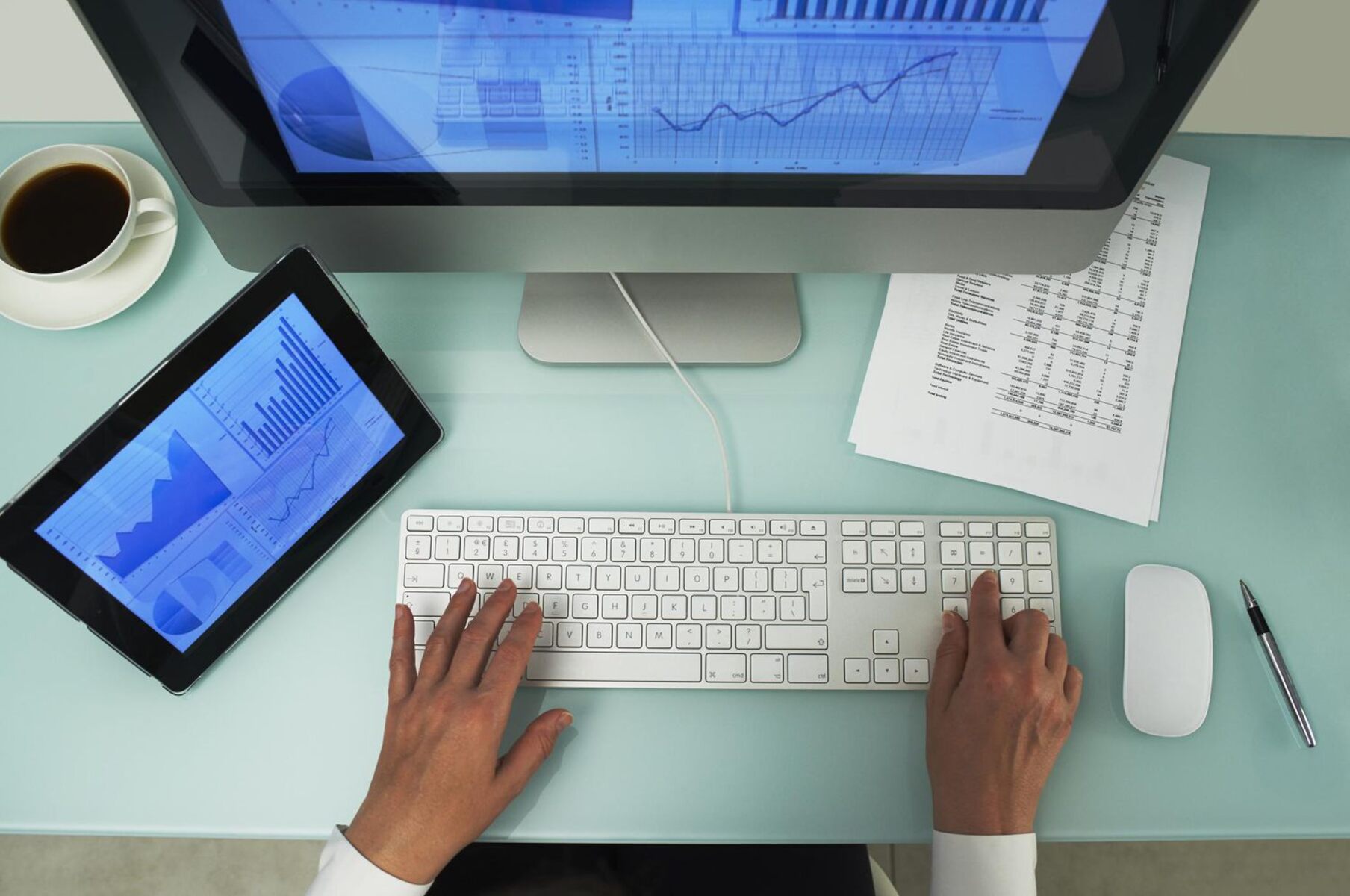Choosing the Right Equipment
When setting up a workstation, one of the first steps is choosing the right equipment. This includes selecting a computer, monitor, keyboard, mouse, and any other accessories required for your work. Here are some factors to consider when making your choices:
- Computer: Determine the specifications and capabilities you need for your work tasks. Consider factors such as processing power, RAM, and storage capacity. If you work with large files or graphics-intensive applications, you may need a more powerful computer.
- Monitor: Choose a monitor with a size and resolution that meets your requirements. A larger screen and higher resolution can enhance your productivity and reduce eye strain.
- Keyboard and Mouse: Opt for ergonomic options that provide comfort during prolonged use. Look for features such as a cushioned wrist rest or adjustable height to minimize the risk of repetitive strain injuries.
- Accessories: Consider additional accessories that may enhance your work experience. This could include items like a document holder, laptop stand, or a wireless headset. These additions can improve efficiency and reduce strain on your body.
Remember to research reviews and seek recommendations before purchasing any equipment. This will help ensure that you are investing in reliable and high-quality products that will support your work needs.
Choosing the right equipment is crucial for creating a comfortable and efficient workstation. It’s important to consider your specific requirements, budget, and long-term goals when making these decisions.
Creating a Comfortable and Ergonomic Workstation
Designing a comfortable and ergonomic workstation is essential for maintaining productivity and preventing physical discomfort. Here are some tips to help you create a workspace that promotes good posture and reduces the risk of musculoskeletal issues:
- Adjust your chair: Ensure that your chair is adjustable in terms of height, backrest, and armrests. Sit with your feet flat on the ground and your knees at a 90-degree angle. Your arms should be comfortably positioned, with your elbows at a 90-degree angle.
- Position your monitor: Place your monitor directly in front of you, at eye level. This will reduce strain on your neck and upper back. Consider using a monitor stand or adjustable arm to achieve the correct height and angle.
- Use an ergonomic keyboard and mouse: These devices are designed to support natural hand and wrist positions. Look for keyboards with wrist rests and consider using an ergonomic mouse that fits comfortably in your hand.
- Utilize proper lighting: Ensure that your workspace is well-lit, with the light source placed behind or beside you to prevent glare on your monitor. Use a desk lamp for additional lighting if needed.
- Take regular breaks: Avoid prolonged periods of sitting. Stand up, stretch, or take short walks every hour to promote blood circulation and reduce muscle stiffness.
Incorporating these ergonomic principles into your workstation setup will improve your posture and reduce the risk of strain or injury. It is important to regularly assess and adjust your setup as needed to maintain optimal ergonomics.
Setting Up the Computer
Setting up your computer correctly is essential for a smooth and efficient workflow. Follow these steps to ensure that your computer is optimized for your needs:
- Install necessary software: Start by installing the operating system and essential software programs required for your work. This may include office productivity tools, design software, or communication applications.
- Configure system settings: Customize your computer’s settings to suit your preferences. Adjust options such as display resolution, power settings, and privacy settings. This will enhance your user experience and maximize performance.
- Set up user accounts: If you share the computer with others, create separate user accounts to maintain privacy and individual preferences. Assign appropriate permissions and password protect your accounts to ensure security.
- Organize files and folders: Create a logical folder structure to store and organize your files. Use descriptive names and subfolders to easily locate and access your documents when needed.
- Install necessary peripherals: Connect and install any necessary peripherals such as printers, scanners, or external storage devices. Ensure that they are properly configured and drivers are up to date.
- Implement security measures: Install reliable antivirus software and regularly update it to protect your computer from viruses and malware. Enable automatic updates for your operating system and software to stay up to date with the latest security patches.
- Backup your data: Set up a regular backup system to protect your important files and documents. Utilize cloud storage or external hard drives to ensure redundancy and safeguard against data loss.
By following these steps, you can ensure that your computer is ready for optimal performance and productivity. Regularly update your software, perform system maintenance, and keep your workspace free from clutter to maintain an efficient and reliable workstation.
Organizing Cables and Wires
One of the common challenges in setting up a workstation is dealing with the tangle of cables and wires. However, with some organization strategies, you can keep your workspace neat, safe, and free from cable clutter. Here are some tips for effectively organizing cables and wires:
- Label cables: Use labels or color coding to identify different cables. This will help you easily identify and trace specific cables when needed.
- Use cable management solutions: Invest in cable management solutions such as cable clips, cable sleeves, or cable boxes. These tools will help you keep cables organized, prevent tangling, and reduce the risk of tripping hazards.
- Bundling cables: Group similar cables together using zip ties or cable ties. This will prevent them from getting tangled and make it easier to manage and identify specific cables.
- Route cables appropriately: Route cables along the back of your desk or use cable management channels. This will keep them out of sight and prevent them from obstructing your workspace.
- Use cable clips or adhesive hooks: Attach cable clips or adhesive hooks to the underside of your desk or walls to hold cables in place and prevent them from hanging loosely.
- Consider wireless options: Whenever possible, opt for wireless peripherals such as a wireless keyboard or mouse. This will reduce the number of cables on your desk.
- Regular maintenance: Periodically check your cables to ensure they are in good condition. Replace any worn-out or damaged cables to maintain a safe and reliable workstation.
By implementing these cable management strategies, you can maintain a clean and organized workspace. Not only will this improve the aesthetics of your workstation, but it will also make it easier to access and manage your devices, leading to a more productive work environment.
Adjusting the Lighting
The lighting in your workspace plays a crucial role in creating a comfortable and productive environment. Proper lighting reduces eye strain, improves focus, and enhances overall well-being. Here are some tips for adjusting the lighting in your workstation:
- Natural light: Position your desk near a window to take advantage of natural light. Natural light can boost your mood and provide a sense of space and openness.
- Avoid glare: Position your monitor perpendicular to windows or use blinds or curtains to control the amount of direct sunlight. Glare on the screen can cause eye strain and affect your visibility.
- Use task lighting: Supplement natural light with task lighting, such as a desk lamp with adjustable brightness. This will ensure that you have adequate illumination for your workspace, especially during darker hours or in dimly lit areas.
- Adjust brightness and color temperature: Experiment with the brightness and color temperature settings of your computer monitor. Adjust them to a level that is comfortable for your eyes, neither too bright nor too dull.
- Consider indirect lighting: Use overhead lighting or wall lights to provide ambient illumination without casting shadows or causing glare on the workstation.
- Install adjustable lighting: If possible, install lighting fixtures with adjustable settings. This will allow you to control the intensity and direction of light based on your specific needs and tasks.
- Take regular visual breaks: Regardless of the quality of lighting, it’s important to give your eyes regular breaks. Look away from the screen and focus on distant objects or practice eye exercises to relax your eye muscles.
By adjusting the lighting in your workstation, you can create an inviting and comfortable atmosphere that promotes productivity and reduces eye strain. Experiment with different lighting setups and find what works best for your unique preferences and needs.
Arranging Desk and Storage Space
The way you arrange your desk and storage space can greatly impact your productivity and efficiency. By organizing your belongings and optimizing your workspace, you can create a functional and clutter-free environment. Here are some tips for arranging your desk and storage space:
- Clear the clutter: Start by decluttering your desk and removing any unnecessary items. Keep only the essentials within arm’s reach to minimize distractions and free up space.
- Utilize desk organizers: Invest in desk organizers, such as pen holders, file trays, and drawer dividers. These tools will help you keep your desk tidy and ensure easy access to frequently used items.
- Arrange items by frequency of use: Organize your desk in a way that prioritizes items based on how often you need them. Keep frequently used items, such as stationery or reference materials, within easy reach.
- Create a filing system: Implement a logical and organized filing system for your physical and digital documents. Use folders, binders, or file cabinets with clear labels to categorize and store your paperwork.
- Use vertical space: Maximize your storage options by utilizing vertical space. Install shelves or floating wall-mounted storage units to keep items off your desk while still easily accessible.
- Keep cables hidden: Use cable management solutions, such as cable clips or cable sleeves, to keep cables neatly organized and hidden from view. This will help minimize cable clutter on and around your desk.
- Designate specific zones: Divide your desk into different zones based on the type of tasks you perform. For example, create a dedicated space for writing, computer work, and reference materials. This will help you stay focused and organized.
- Personalize your space: Add personal touches to your desk and storage space with items that inspire and motivate you. Whether it’s a small plant, a photo frame, or a motivational quote, surround yourself with things that bring you joy and create a positive work environment.
By arranging your desk and storage space in an organized and efficient manner, you can improve your workflow and reduce distractions. Regularly assess and declutter your workspace to maintain a clean and productive environment.
Creating a Productive Work Environment
The environment in which you work can significantly impact your productivity, focus, and overall job satisfaction. To create a productive work environment, consider the following factors:
- Minimize distractions: Remove or minimize any distractions that can interrupt your workflow. This might include turning off notifications on your phone, blocking distracting websites, or finding a quiet space to work.
- Set clear goals: Establish clear goals and priorities for each work session. This will help you stay focused and motivated, as well as maintain a sense of direction and purpose.
- Establish a routine: Establishing a consistent work routine can help you get into a focused mindset and boost productivity. Create a schedule that includes designated work hours, breaks, and specific tasks to accomplish.
- Manage your time effectively: Use time management techniques such as the Pomodoro Technique or time blocking to optimize your productivity. Break your work into manageable chunks and allocate specific time frames to complete each task.
- Create a comfortable workspace: Ensure that your workspace is comfortable and ergonomically sound. Invest in a supportive chair, adjust your monitor and keyboard to optimal heights, and maintain good posture to avoid physical discomfort and fatigue.
- Prioritize self-care: Take care of your physical and mental well-being to maintain productivity. Get enough sleep, eat nourishing meals, exercise regularly, and practice stress-management techniques such as meditation or deep breathing exercises.
- Stay organized: Maintain an organized workspace by implementing effective storage solutions, utilizing digital tools for file management, and keeping a to-do list or planner to stay on top of tasks.
- Create a positive atmosphere: Incorporate elements that promote positivity and motivation in your workspace. This could include motivational quotes, inspiring artwork, or listening to uplifting music while you work.
- Collaborate and communicate: Foster open communication and collaboration with colleagues. Regularly update others on your progress, seek feedback and support, and participate in team discussions to maintain a sense of connection and productivity.
- Take breaks: Allow yourself regular breaks throughout the workday. Taking short breaks can refresh your mind, increase focus, and prevent burnout.
By considering these factors and implementing strategies that work for you, you can create a productive work environment conducive to achieving your goals and maintaining a healthy work-life balance.
Personalizing Your Workspace
Your workspace should reflect your personality and inspire creativity and motivation. Personalizing your workspace not only makes it more enjoyable but also helps create a sense of ownership and pride in your work. Here are some ideas to personalize your workspace:
- Add meaningful decorations: Display items that hold personal significance, such as photographs, artwork, or mementos. These can serve as reminders of happy memories or goals you are working towards.
- Incorporate plants: Bring nature indoors by adding plants to your workspace. Plants not only purify the air but also add vibrancy and a sense of tranquility to your surroundings.
- Choose a color scheme: Select a color scheme that you find appealing and calming. Use this color palette for your desk accessories, organizers, or even the wallpaper on your computer screen.
- Use motivational quotes: Hang up posters or write down inspirational quotes that resonate with you. These can serve as gentle reminders to stay focused, motivated, and positive throughout the workday.
- Create a vision board: Design a vision board or inspiration board to visualize your goals and aspirations. Pin up images, quotes, or articles that inspire you and align with your professional aspirations.
- Invest in comfortable and stylish office supplies: Use desk accessories, such as a stylish pen holder or a unique mousepad, that bring joy and functionality to your workspace. Aesthetic and functional office supplies can enhance your overall work experience.
- Play background music: Set the mood with background music that helps you focus and relax. Choose genres or playlists that align with your work tasks and personal preferences.
- Keep a personal journal: Keep a journal on your desk to jot down thoughts, ideas, or achievements. This can serve as a creative outlet and a way to reflect on your progress and personal growth.
- Create a cozy corner: If space permits, designate a cozy corner with a comfortable chair, a soft blanket, and a small reading nook. This can serve as a relaxation space or a place for quiet contemplation during breaks.
- Display meaningful quotes or affirmations: Write down positive affirmations or motivational quotes on sticky notes or small whiteboards. Place them where you can easily see them throughout the day as reminders of your capabilities and worth.
Personalizing your workspace allows you to create an environment that brings you joy, motivation, and a sense of belonging. Experiment with different ideas and find what resonates with you, making your workspace an extension of your personality and style.
Maintaining a Clean and Clutter-Free Workstation
A clean and clutter-free workstation is essential for productivity, focus, and overall well-being. A disorganized workspace can lead to distractions and hinder your ability to work efficiently. Here are some tips for maintaining a clean and clutter-free workstation:
- Declutter regularly: Take the time to declutter your workspace on a regular basis. Remove any unnecessary items, papers, or office supplies that are not being used or are no longer needed.
- Organize your documents: Create a filing system for your physical and digital documents. Sort and categorize important papers into labeled folders or use digital folders to store and organize digital files.
- Use storage solutions: Invest in storage solutions such as drawers, shelves, or file organizers to keep your materials and supplies neatly stored and easily accessible.
- Designate a place for everything: Assign a specific place for each item on your desk. This makes it easier to find things quickly and prevents items from accumulating in random places.
- Minimize paper clutter: Whenever possible, go digital and store documents electronically rather than in physical form. Use electronic tools for note-taking and file sharing to reduce paper clutter.
- Keep only essentials on your desk: Remove any unnecessary items from your desk, such as knick-knacks or excessive stationery. Only keep essential items within reach to maintain a clean and efficient workspace.
- Implement a “clean desk” policy: At the end of each workday, take a few minutes to clear your desk and put everything back in its designated place. This helps you start the next day fresh and organized.
- Use cable management solutions: Tangled cables not only create a cluttered appearance but also pose a safety hazard. Utilize cable management solutions such as clips or sleeves to keep cables organized and out of the way.
- Wipe down surfaces regularly: Dust and dirt can accumulate on your desk and equipment over time. Regularly wipe down your surfaces with a damp cloth or cleaning solution to maintain a clean and hygienic workspace.
- Encourage an organized mindset: Cultivate a habit of maintaining an organized workspace. Train yourself to put things back in their designated places immediately after use to prevent clutter from building up.
By incorporating these practices into your daily routine, you can enjoy a clean and clutter-free workstation that promotes focus, efficiency, and a sense of calm. Regularly reassess and declutter your space to maintain an organized and productive work environment.

























